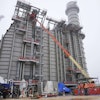Chem.Info has teamed up with industry experts in order to help answer your processing-related questions. Each month, we will focus on a different topic. We look forward to providing up-to-the minute answers to your processing questions!
December’s Topic: Level Measurement
Our level-measurement expert: Joe Lewis, Managing Director at BlueLevel Technologies
BlueLevel Technologies can answer questions relating to level measurement, especially for powder and bulk solids applications. Visit www.blueleveltechnologies.com to learn more!
Click here to submit a question!
We will forward your question to the experts, and post your question as well as the expert’s response below as soon as possible. Because questions will be posted directly to our site, please only include information that you are willing to share publicly. Be sure to check back to see the latest questions and answers! We will post questions and answers shortly after they are submitted, so new content will be available throughout the month!
-----------------------------------------------------------------------------------------------------
Last Month’s Topic: Conveying Equipment
Snag: For cement-handling plants that experience reduced cement production due to excessive wear on equipment, can efficiency be improved by improving equipment design?
Solution: Abrasive wear of equipment handling bulk materials is a function of four primary factors, namely: hardness of the bulk solid; softness of the wear (contact) surface; solids velocity past the surface; and pressure of the solids against the surface. With abrasive bulk materials, such as fly ash, cement, iron ore, and sand, handled at a cement plant, maintenance managers are routinely replacing solids handling equipment like rotary valves, screw feeders, belt scrapers, and chutes, and bucket elevators.
The key to reducing abrasive wear problems is to carefully identify the mechanism causing the wear. For instance, is it high stream velocity through a transfer chute or perhaps high impact pressure due to a poor chute design? Is the wear surface soft from a high temperature condition, such as in a kiln clinker cooler, or could it be a plastic liner in a hopper incorrectly used with an abrasive bulk solid?
Once the wear mechanism is understood, then a variety of wear reduction tools can be used. For example, a wear resistant material, such as basalt, high alumina ceramic, or hardened steel could be used as a hopper or chute liner. Alternatively, a design change to the equipment could reduce abrasive wear. For instance, a transfer chute could be redesigned to avoid an abrupt stream impact that occurs with high pressure wear effects. Or, in a pneumatic conveying line, a blind-tee or HammerTek specialty elbow could be used to have bulk material on bulk material wear (like a rock box) instead of abrasive material on steel elbow wear.
Jenike & Johanson engineers have specialized knowledge to provide practical solutions for costly abrasive wear problems. We have developed innovative laboratory tests to assess hopper liner longevity, chute wear surface viability, and specialty elbow designs for abrasive solids that are pneumatically conveyed. We can then use the test results to recommend the most cost-effective and practical wear resistant equipment solutions for your cement plant.
Solution provided by: Eric Maynard, Senior Consultant, Director of Education, Jenike & Johanson, Inc.
-----------------------------------------------------------------------------------------------------
Snag: A facility is experiencing poor flow when handling fly ash. What might be causing this issue and what can be done to make fly ash flow more efficiently?
Solution: Fly ash is typically a very fine powder (100 percent passing 100 micron or 150 US mesh) that is derived from the combustion of coal, biomass, or other fuels. Due to its fine size, this powder can be prone to bin or silo flow obstructions, such as bridges and ratholes. Besides these no flow problems, fly ash can flood or flush from a bin flowing just like a liquid. Screw and belt feeders in this case are not capable of holding back the flooding fly ash, which results in spillage, dusting, and the process being out of control. Stagnant fly ash can often cake and form very hard lumps that mechanically interlock over a hopper outlet restricting discharge.
Fly ash is quite frictional against most hopper surfaces made from steel, aluminum, or having an epoxy coating. Furthermore, most hoppers handling fly ash are relatively shallow, thus inducing a funnel flow discharge pattern which does not allow flow along the hopper walls. Given funnel flow and this material's cohesive strength when deaerated, fly ash routinely bridges in hoppers and experiences ratholing.
Ideally, the fly ash will be handled in a mass flow bin or silo, whereby all of the fly ash is in motion during discharge and as a result, no stagnant regions exist. Ratholing is eliminated, and the outlet can be properly sized based on the required discharge rate and critical dimension needed to prevent bridging.
Achieving mass flow discharge relies upon fly ash flow testing. Not all fly ash behaves the same, even though it is classified as fly ash. For instance, fly ash from bituminous coal combustion without clean coal technology can flow quite differently than fly ash that has been through scrubber systems for SO2, NOx, and mercury. Additionally, fly ash production from biomass combustion is far more voluminous than what occurs for coal. These apparently minor differences can have major effects on achieving reliable flow with this material.
Fly ash could be aerated to enhance hopper discharge, or even have wall heaters on hoppers to reduce surface buildup; however, to determine the effectiveness of these approaches, powder testing is required to eliminate the guess-work or costly trial-and-error approach.
Jenike & Johanson routinely performs flow properties testing on samples of fly ash to determine critical flow characteristics such as cohesive strength (providing bridging and ratholing behaviors), wall friction (providing critical angles/surfaces needed for mass flow in hoppers), bulk and particle densities, and permeability (providing critical discharge rates for fine powders). Having this vital flow information takes the guess-work out of hopper design and allows accurate, cost-effective, and safe design of fly ash handling equipment.
Solution provided by: Eric Maynard, Senior Consultant, Director of Education, Jenike & Johanson, Inc.
For more information on Jenike & Johanson, please visit www.jenike.com























